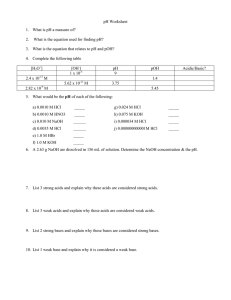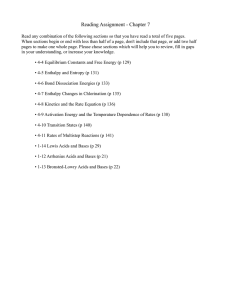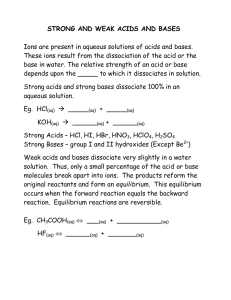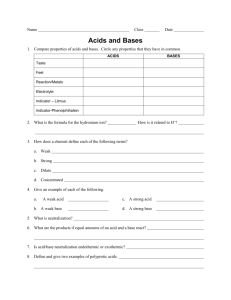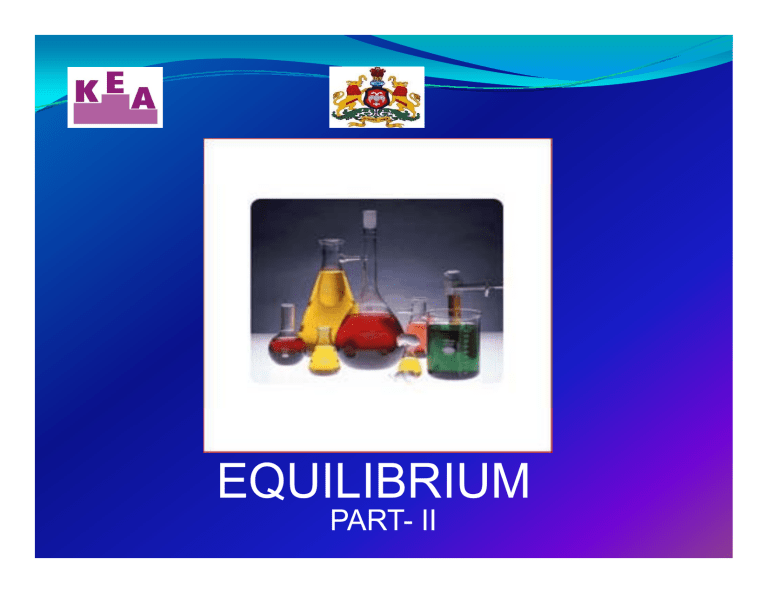
EQUILIBRIUM PART- II y ACIDS ¾Defination D fi ti ¾Basicity of an acid ¾Classification Cl ifi ti off acids id y BASES ¾Defination ¾Acidity of base ¾Classification of bases y ALKALI y NEUTRALISATION y SALTS ACIDS USED IN DAILY LIFE. LIFE y Milk contains lactic acid. y Carbonic acid is responsible for the fizz in soft drinks. Ascorbic A bi acid id is i the th chemical h i l name off vitamin –C. Vinegar used in cooking contains approximately 4 % acetic acid. Sulphuric acid is used in the manufacture of car batteries. T il t cleaner Toilet l What is an acid? ACIDS An acid is a substance which contains one or more replaceable hydrogen atoms and dissociates in solution giving hydrogen ions( H+ ). ) Ex : 2 HCl + 2 Na→ 2NaCl + H2 one molecule of HCl contains one replaceable hydrogen h drogen atom atom. HCl (aq) → H+ + Cl- y H2SO4 (aq) + Zn Z → ZnSO Z SO4 + H2 o e molecule one o ecu e o of H2SO4 co contains ta s ttwo o replaceable hydrogen atoms. y H2SO4 (aq) → 2 H+ + SO4 2y HNO3 (aq) → H+ + NO3 – y CH3COOH +NaHCO3 → CH3COONa COON + CO2 + H2O one molecule of CH3COOH contains one replaceable hydrogen atom. y CH3COOH (aq) → H+ + CH3COO – g Mineral acids and organic acids. y A mineral acid (or inorganic acid) is an acid derived from one or more inorganic g compounds. p y All mineral acids form hydrogen ions when dissolved in water. Ex: HCl , HNO3 H2SO4 etc Organic compounds having acidic property p p y are organic g acids. Ex: Carboxylic acids HCOOH CH3COOH C6H5COOH BASICITY OF AN ACID It is the number of replaceable hydrogen atoms present in a molecule of an acid. CLASSIFICATION OF ACIDS : Depending D di on th the b basicity i it off th the acids, id theyy are classified as: y Monobasic acid y Dibasic Dib i acid id y Tribasic acid etc. MONOBASIC ACID Monobasic acid contains one replaceable hydrogen atom in a molecule. Ex : Hydrochloric y acid - HCl Nitric acid - HNO3 For organic acids basicity is the number of -COOH groups present in the molecule molecule. Ex : HCOOH CH3COOH C6H5COOH DIBASIC ACID Dibasic acid contains two replaceable hydrogen atoms in a molecule. Ex : Sulphuric acid - H2SO4 Oxalic acid - C2 H2O4 ( HOOC – COOH)) TRIBASIC ACID A tribasic acid contains three replaceable hydrogen atoms in a molecule. Ex : Orthophosphoric acid - H3PO4 y Almost all inorganic acids are soluble in water water. y For volumetric analysis, solution of acids having different concentrations are p p prepared. y Concentration of acids are expressed in normality or molarity. Why SO3 , BF3 etc are acids? BASES USED IN DAILY LIFE. Antacids help to neutralize the acidity in the th stomach. t h They mainly contain two bases: Mg(OH)2 & Al(OH)3 Potassium hydroxide is used in the manufacture of alkaline batteries batteries. Ammonia is a basic gas which is used in the manufacture of fertilizers such as : y urea y ammonium nitrate y ammonium phosphate. What is a base? BASES y A base is a substance which dissociates in solution giving hydroxyl ( OH - ) ions. ions Th oxides The id and dh hydroxides d id off metals t l are bases or basic in nature. Ex : Sodium hydroxide ( NaOH )is a base. NaOH dissociates in solution NaOH → Na+ + OH – y Calcium hydroxide Ca(OH)2 is a base Ca(OH)2 dissociates in solution solution. Ca(OH)2 → Ca2+ + 2 OH – y Aluminium hydroxide Al(OH)3 is a base Al(OH)3 dissociates in solution. Al(OH)3 → Al3+ + 3 OH – y ACIDITY OF BASE It is the number of molecules of monobasic acid required to neutralize one molecule of a base. Ex : NaOH + HCl → NaCl + H2O Acidity of NaOH is one or NaOH is monoacidic base. Ca(OH)2 + 2HCl → CaCl2 + 2H2O Acidity of Ca(OH)2 is two or Ca(OH)2 is diacidic base. Al(OH)3 + 3HCl → AlCl3 + 3H2O Acidity of Al(OH)3 is three or Al(OH)3 is triacidic base base. ACIDITY OF BASE Acidityy of hydroxide y is the number of hydroxyl (OH) groups present in a molecule of itit. Base NaOH Ca(OH)2 Al(OH)3 Acidity 1 2 3 H How tto d detect t t the th acids id & b bases? ? y Acids turns blue litmus to red. red y Bases turns red litmus to blue. Why CaO ,MgO are bases? ALKALI The bases which are readily soluble in water are called alkali alkali. yOxides and hydroxides of “group - 1 ’’ metals of long form of periodic table are readily soluble in water. They are called alkalies. alkalies yThese metals are called alkali metals. Ex: y NaOH is a base and also an alkali. y KOH is a base and also an alkali. y Mg(OH)2, Ca(OH)2 are bases only but not alkalies. All the alkalies are bases but all the bases are not alkalies. NEUTRALISATION The reaction between an acid and a base in dilute aqueous solution is called neutralisation reaction. Ex: HCl(aq)+ NaOH (aq)→ NaCl(aq) + H2O H2SO4(aq)+ 2NaOH 2N OH (aq)→Na N 2SO4 (aq) + 2H2O CH3COOH +NaOH → CH3COONa + H2O What are salts? SALT The Chemical substance obtained as a result of neutralisation reaction between an acid and a base is called salt. Ex: HCl(aq)+ NaOH(aq) →NaCl(aq)+ H2O y H2SO4 (aq)+ 2NaOH(aq)→Na2SO4(aq)+2H2O y HNO3 ((aq) q) + NaOH((aq) q) → NaNO3(aq) ( q) +H2O y HCl(aq) + KOH(aq) y HNO3 (aq) + KOH(aq) → KCl(aq) +H2O → KNO3(aq) +H2O
